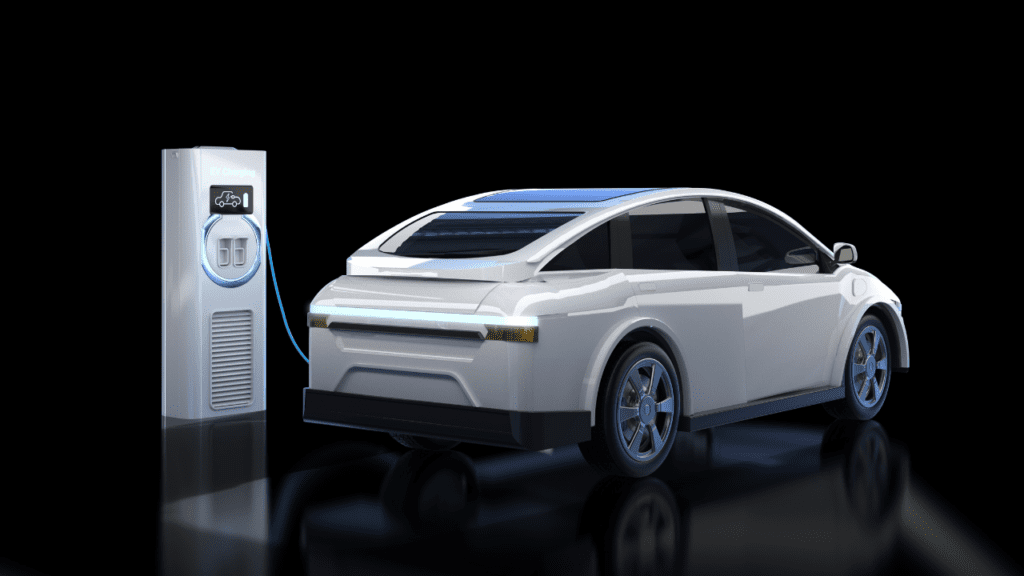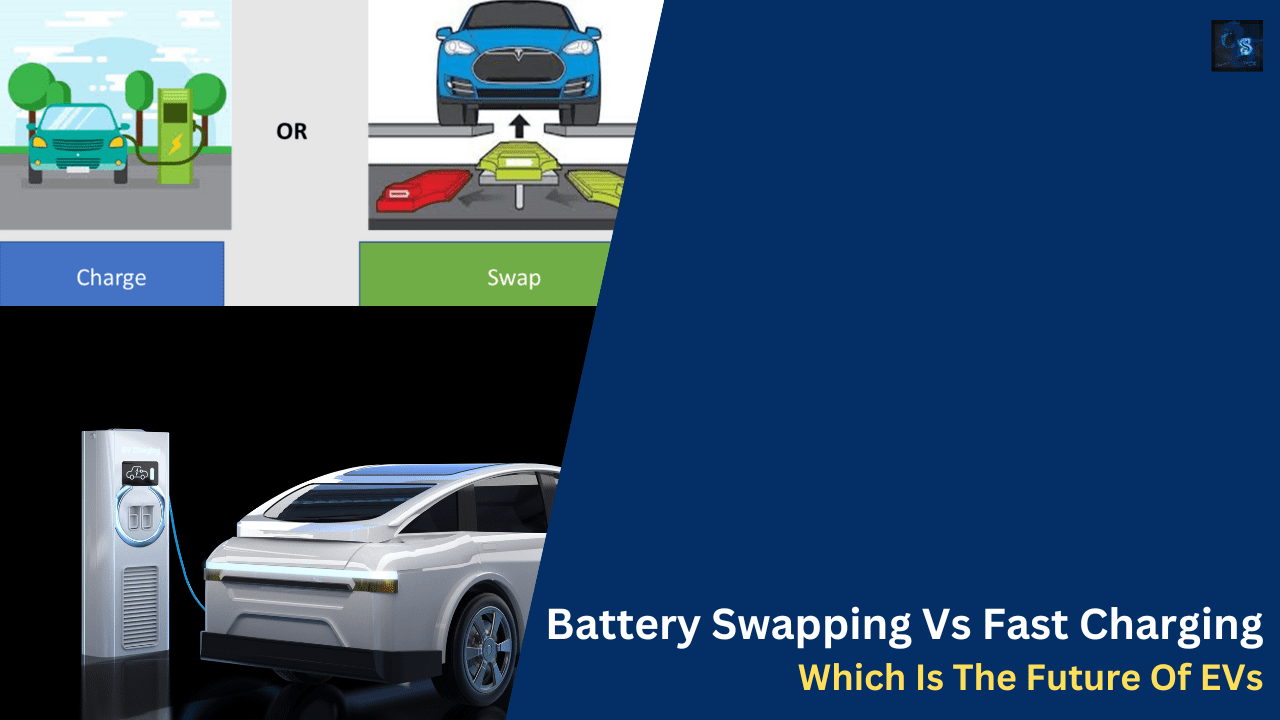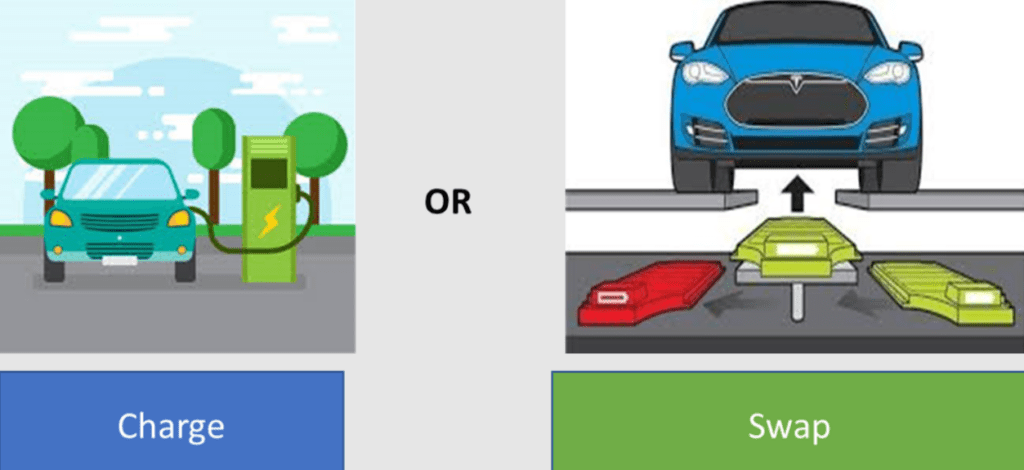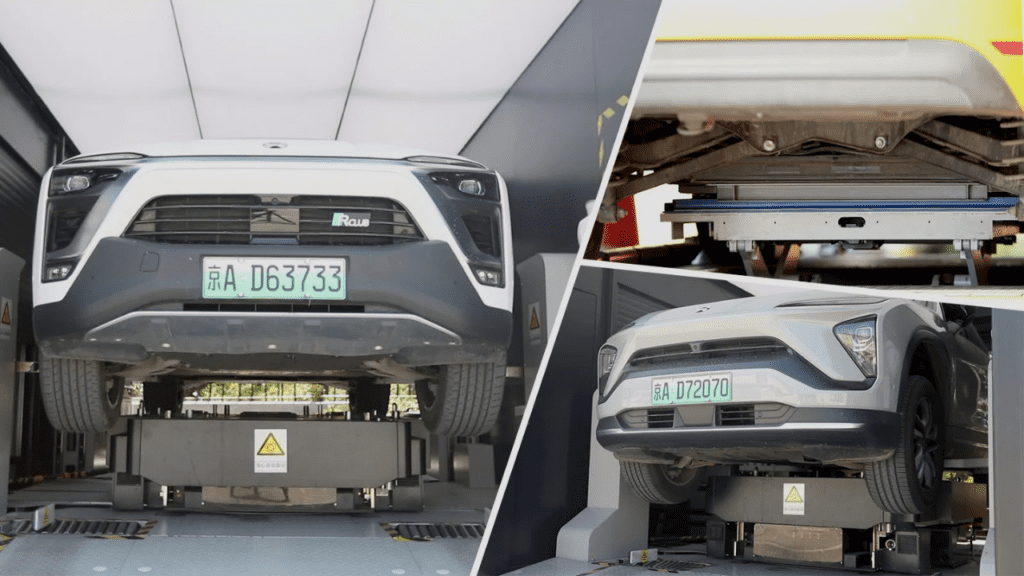Battery Swapping Vs Fast Charging: Which Is The Future Of EVs
Hello guys, welcome back to our blog. Here in this article, I will discuss battery swapping technology Vs fast charging technology, and which is going to be the future of electric vehicles.
Ask questions if you have any electrical, electronics, or computer science doubts. You can also catch me on Instagram – CS Electrical & Electronics
- Future Of Solid-State Batteries In Electric Vehicles
- Convergence Of VLSI and Automotive Technologies: Driving Innovation In Modern Vehicles
- FuSa Functional Safety ISO26262 Interview Questions Asked In Benz, Daimler, Volvo, Qualcomm, Bosch, Automotive Companies
Battery Swapping Vs Fast Charging
The rapid growth of the electric vehicle (EV) market has brought with it an increasing focus on the technologies that power these vehicles. Among the most debated topics is the charging infrastructure—specifically, the choice between battery swapping and fast charging. Both methods aim to reduce the downtime associated with recharging an EV, but they approach the problem in fundamentally different ways. This article explores the underlying technologies, economic and environmental implications, real-world applications, and the future prospects of both battery swapping and fast charging, to answer the pressing question: which is more likely to shape the future of EVs?
Introduction
The automotive industry is in the midst of a dramatic transformation. As governments worldwide push for reduced carbon emissions and consumers increasingly embrace sustainable transportation, electric vehicles have emerged as a cornerstone of the green revolution. However, one of the biggest hurdles for widespread EV adoption has been the charging time. Traditional charging methods can leave drivers waiting for hours—a stark contrast to the few minutes it takes to refuel a gasoline-powered vehicle.
Enter two innovative solutions: battery swapping and fast charging. Battery swapping involves replacing a depleted battery with a fully charged one at specialized service stations, whereas fast charging delivers high-powered electricity directly to the battery in a matter of minutes. Both systems promise to address range anxiety and improve the convenience of owning an EV.
The allure of battery swapping lies in its ability to virtually eliminate wait times, offering a process that mirrors the quick turnaround of refueling a conventional car. Conversely, fast charging builds on incremental improvements in charging speed and battery technology, aiming to reduce downtime while maintaining the integrity of the battery. Yet, despite the clear benefits, each system faces its own unique set of challenges—ranging from technological constraints and high capital investment to standardization issues and safety concerns.
In the following sections, we will delve deeper into the evolution of these technologies, analyze the technical details and trade-offs, assess the economic and environmental impacts, and examine real-world case studies. By understanding these dynamics, stakeholders—including manufacturers, policymakers, and consumers—can better gauge which method is poised to dominate the EV landscape.
Background: Understanding the Charging Paradigms
The Evolution of EV Charging
EV charging technology has evolved significantly since the early days of electric mobility. Initially, the focus was on simply enabling vehicles to be recharged at home overnight using standard outlets. However, as EV adoption grew, the need for public charging infrastructure became apparent. This need gave rise to various charging solutions, from slow Level 1 chargers to high-powered DC fast chargers.
Simultaneously, battery technology underwent rapid development. Advances in lithium-ion chemistry, improved energy density, and more efficient power management systems have all contributed to reduced charging times and increased vehicle range. Today, EV manufacturers are exploring even more innovative solutions, such as battery swapping, which aims to address the limitations of current charging paradigms.
What Is Battery Swapping?
Battery swapping is a system in which the depleted battery of an EV is quickly removed and replaced with a fully charged one. This process typically takes just a few minutes, making it comparable in speed to refueling a conventional vehicle. Battery swapping stations are designed to accommodate various battery modules and often include robotics or automated systems to facilitate the exchange.
Key Features of Battery Swapping:
- Speed and Convenience: The swap process can be completed in as little as 3–5 minutes.
- Uniform Battery Design: To be effective, battery swapping requires standardization of battery sizes, connectors, and mounting systems across different models and manufacturers.
- Infrastructure Investment: Setting up battery swapping stations is capital intensive, as it requires a network of standardized batteries and sophisticated automated systems.
- Battery Ownership Models: Some companies propose models where the battery is leased rather than owned by the consumer, thus ensuring that batteries are maintained and updated as technology improves.
What Is Fast Charging?

Fast charging, on the other hand, is an evolution of traditional charging methods that use high-power chargers to deliver a significant amount of electricity in a short period. Modern fast chargers can often charge an EV battery to 80% in 20–30 minutes. Unlike battery swapping, fast charging does not require the physical exchange of battery modules; instead, it focuses on optimizing the charging process through improved electronics and battery management systems.
Key Features of Fast Charging:
- Infrastructure Flexibility: Fast chargers can be installed at existing gas stations, parking lots, and public areas.
- Technological Enhancements: Improvements in DC charging technology and battery thermal management have led to substantial reductions in charging time.
- Battery Degradation: Rapid charging cycles can lead to increased battery wear over time if not managed properly, though advances in battery chemistry are mitigating these effects.
- Consumer Familiarity: Most EV drivers are already accustomed to charging their vehicles, and the integration of fast charging is a natural extension of current practices.
Both battery swapping and fast charging represent viable strategies to overcome the traditional limitations of EV charging, but each comes with distinct advantages and drawbacks that influence their future adoption.
Technical Analysis: How Do They Compare?
In this section, we explore the technical underpinnings, operational challenges, and benefits of battery swapping and fast charging. The discussion is divided into several key technical areas, including charging speed, battery health, infrastructure requirements, and system integration.
Charging Speed and Time Efficiency
Battery Swapping:
- Rapid Process: Battery swapping stations can complete the exchange process within minutes. For drivers, this is almost as quick as filling up a gas tank.
- Minimal Wait Times: Because the battery is pre-charged, drivers experience virtually no downtime waiting for energy to be transferred into their vehicle.
- Operational Efficiency: The rapid turnover can potentially keep a higher number of vehicles on the road, making it ideal for commercial fleets and high-usage scenarios.
Fast Charging:
- Accelerated Charging Cycles: Modern fast chargers can bring an EV battery from 20% to 80% capacity in roughly 20–30 minutes, though charging speeds often slow down after 80% to protect battery health.
- Incremental Improvements: Advances in charging technology continue to push these times down, with some prototype systems promising even faster turnaround times.
- Battery Constraints: While fast charging is convenient, it still requires the battery to absorb energy at a high rate, which can generate heat and stress the battery’s internal components.
Battery Health and Longevity
Battery Swapping:
- Optimized Battery Management: Battery swapping services allow providers to maintain and monitor battery health actively. Batteries can be cycled through optimal charging routines and even replaced before their performance degrades.
- Standardization: Uniform battery design and regular maintenance schedules could lead to extended battery lifespans, reducing long-term ownership costs.
- Potential Risks: However, if not carefully managed, battery swapping may introduce risks related to battery compatibility and integration issues, particularly if standardized protocols are not rigorously enforced.
Fast Charging:
- Thermal Management Challenges: Fast charging generates significant heat, which, if not effectively dissipated, can reduce battery life. Manufacturers employ sophisticated cooling systems to mitigate these risks.
- Battery Degradation: Frequent exposure to high charging currents can accelerate battery degradation. Recent research focuses on new battery chemistries and materials that are more resilient to fast charging cycles.
- Advances in Technology: New developments in solid-state batteries and improved battery management systems may eventually reduce or eliminate these issues, making fast charging a more viable option for everyday use.
Infrastructure and Capital Investment
Battery Swapping:
- High Initial Costs: The establishment of battery swapping stations requires a significant upfront investment. This includes the cost of automated swapping systems, a stockpile of standardized batteries, and real estate.
- Centralized Maintenance: The centralized nature of battery management in a swapping system allows for more efficient servicing and replacement cycles, but only if the network is sufficiently dense.
- Standardization Challenges: To be effective, battery swapping requires industry-wide standardization, which is challenging in a market with multiple manufacturers and proprietary battery designs.
- Scalability: While promising in controlled environments or regions with high EV density, battery swapping may face scalability issues in more diffuse markets.
Fast Charging:
- Leverage Existing Infrastructure: Fast charging stations can often be integrated into existing service areas such as highways, shopping centers, and parking garages, potentially reducing initial costs.
- Flexible Deployment: As technology advances, fast charging stations can be upgraded or expanded incrementally. This flexibility makes fast charging more adaptable to evolving market conditions.
- Cost of Upgrades: Despite these advantages, the cost of installing high-power fast charging infrastructure can be prohibitive, especially in rural or underdeveloped regions.
- Utility Upgrades: The installation of fast chargers may also necessitate upgrades to local electrical grids, which involves coordination with utility companies and additional investment.
System Integration and User Experience
Battery Swapping:
- Seamless User Experience: For the end user, battery swapping can mimic the simplicity and speed of refueling a conventional car, requiring a minimal learning curve.
- Interoperability: The success of a swapping system depends on the interoperability between different EV models and the standardization of battery modules. This requires significant coordination across the automotive industry.
- Operational Complexities: While the concept is straightforward, the logistics behind battery tracking, charging management, and quality assurance can be complex. Any failure in the system could lead to widespread operational disruptions.
- Regulatory Hurdles: Battery swapping systems might face additional regulatory scrutiny regarding battery safety, transportation, and disposal, all of which add to the complexity of implementation.
Fast Charging:
- User Familiarity: Most EV drivers are already familiar with the concept of plugging in and charging, making fast charging a more intuitive option.
- Software Integration: Advances in app-based navigation and charging station locators have enhanced the user experience by allowing drivers to plan their trips around available fast chargers.
- Flexibility: Fast charging stations offer a more flexible solution for different driving patterns. Whether you’re on a long road trip or need a quick top-up in the city, fast charging is adaptable to a variety of use cases.
- Technical Reliability: However, fast charging stations are not immune to technical issues such as downtime or connectivity problems, which can affect the overall reliability of the system.
Economic and Environmental Considerations
Economic Viability and Cost Implications
Battery Swapping:
- Operational Costs: Battery swapping requires centralized battery ownership, meaning operators must bear the cost of battery maintenance, storage, and periodic replacement. However, the potential to optimize battery health through professional management could offset some of these costs.
- Consumer Economics: For consumers, a battery swapping model might shift the cost from a large upfront battery purchase to a subscription or leasing model. This can reduce the initial purchase price of EVs and make them more accessible.
- Business Models: Innovative business models are emerging around battery swapping. For example, fleet operators may benefit significantly from swapping systems due to the rapid turnaround time, which minimizes vehicle downtime. Additionally, companies that specialize in swapping could potentially generate recurring revenue through battery leasing agreements.
- Standardization Costs: The lack of standardization in battery design can increase costs, as manufacturers might need to retrofit vehicles or develop proprietary systems. Successful widespread adoption hinges on the industry reaching consensus on standardized battery modules.
Fast Charging:
- Capital Expenditure: Fast charging infrastructure requires high-power electrical components and robust grid connections, leading to significant capital expenditure. However, because fast charging stations can be installed incrementally, the financial burden can be spread over time.
- Consumer Costs: For drivers, fast charging offers a pay-per-use model, which may prove more cost-effective for those who do not require frequent or rapid recharging. Nonetheless, higher charging rates may be associated with higher fees at premium stations.
- Grid and Utility Coordination: Investments in fast charging infrastructure are often coupled with upgrades to local electrical grids. While this has long-term benefits, the immediate cost implications can be a barrier in some regions.
- Economic Scale: As fast charging networks expand and technology advances, economies of scale may drive down costs. Additionally, government incentives and subsidies aimed at reducing carbon emissions can further improve the economic viability of fast charging stations.
Environmental Impact and Sustainability
Battery Swapping:
- Lifecycle Management: Battery swapping offers the opportunity to centrally manage the entire lifecycle of the battery—from production to recycling. This centralized management could lead to more sustainable practices, such as improved recycling processes and the repurposing of used batteries for energy storage.
- Reduced Emissions: Rapid swapping stations can reduce idle time and associated emissions from vehicles waiting to be charged, contributing indirectly to lower urban pollution levels.
- Resource Utilization: However, the infrastructure for battery swapping itself demands significant resource investment. The manufacturing of additional battery units (to keep spares in the field) and the energy required for maintaining these stocks are important environmental considerations.
- Recycling and Reuse: Proper disposal and recycling protocols are essential to ensure that the environmental benefits of EVs are not negated by the challenges associated with battery waste.
Fast Charging:
- Energy Efficiency: Fast charging, while efficient in terms of time, is energy-intensive. The environmental footprint of fast charging depends on the source of the electricity. When powered by renewable energy sources, fast charging can be a very sustainable option.
- Heat and Energy Loss: High charging rates inherently lead to energy losses through heat, and if not managed efficiently, this can contribute to a larger carbon footprint. Innovations in cooling and energy recovery systems are key to addressing these challenges.
- Infrastructure Footprint: The deployment of fast charging stations involves substantial material and energy inputs, particularly in the manufacturing of high-power electronic components and the installation of robust electrical infrastructure.
- Policy Support: Government policies that promote renewable energy integration and provide incentives for sustainable infrastructure development can help mitigate the environmental impact of fast-charging systems.
Case Studies and Industry Trends
Pioneers of Battery Swapping
One of the most prominent examples of battery swapping in action comes from NIO, a Chinese EV manufacturer that has invested heavily in developing a battery swapping network. NIO’s approach is to offer a battery-as-a-service (BaaS) model, allowing consumers to buy the car without the battery and then subscribe to a battery service separately. This model reduces the upfront cost of the vehicle and enables centralized management of battery performance.
Key Takeaways from NIO’s Experience:
- Rapid Expansion: NIO has built a robust network of swapping stations, particularly in urban centers and along major highways in China. Their stations typically feature advanced robotic systems that enable swaps in just a few minutes.
- Consumer Adoption: Early adopters have appreciated the speed and convenience of the service, particularly in regions where EV charging infrastructure is still developing.
- Operational Challenges: Despite its success, NIO’s model has faced challenges related to the high costs of maintaining a large inventory of batteries and ensuring compatibility as new battery technologies emerge.
Leaders in fast-charging
In contrast, companies like Tesla, Electrify America, and ChargePoint have focused on expanding fast charging networks. Tesla’s Supercharger network is one of the most extensive fast charging infrastructures in the world, strategically located along major travel routes to facilitate long-distance journeys.
Key Takeaways from Fast Charging Networks:
- Extensive Reach: Tesla’s Superchargers and other fast charging networks have dramatically reduced range anxiety by ensuring that drivers can find a charging station when needed.
- Technological Innovation: Continuous improvements in charger design and battery thermal management have allowed fast charging times to steadily decrease, bringing the user experience closer to that of conventional refueling.
- Scalability: The relatively modular nature of fast charging stations has allowed for more flexible deployment, particularly in regions where urban infrastructure supports rapid upgrades and expansions.
- Consumer Confidence: The reliability and growing ubiquity of fast charging have helped cement EVs as a viable alternative to fossil-fueled vehicles for many drivers.
Emerging Trends and Hybrid Approaches
The future of EV charging may not be a binary choice between battery swapping and fast charging. Some experts predict that a hybrid model—where both technologies coexist and complement each other—could emerge. For instance:
Urban vs. Rural Deployment: Battery swapping might be more effective in densely populated urban areas or for commercial fleets where rapid turnaround is critical. Conversely, fast charging may be more practical in suburban or rural areas where infrastructure is already in place.
Technological Convergence: Advances in battery technology, such as modular designs or standardized interfaces, could pave the way for a system that integrates both swapping and fast charging. Imagine a future where vehicles are designed to support both quick battery swaps and rapid direct charging, depending on the situation.
Data-Driven Optimization: With the proliferation of connected vehicles and smart grids, charging networks could dynamically allocate resources. For instance, during periods of peak demand, battery-swapping stations could be prioritized in urban centers, while fast charging stations handle the more routine charging needs of individual drivers.
Future Outlook: Which Technology Will Prevail?
Market Dynamics and Consumer Preferences
The decision between battery swapping and fast charging is not solely a technical or economic one; it is also deeply influenced by market dynamics and consumer behavior. Factors such as convenience, reliability, upfront costs, and even brand loyalty play crucial roles.
- Convenience and Speed: Battery swapping offers unmatched speed, making it highly attractive for users who need to minimize downtime. However, fast charging is becoming increasingly efficient and familiar to most EV users.
- Cost Considerations: The battery-as-a-service model associated with battery swapping could lower the barrier to EV adoption by reducing upfront costs. Conversely, fast charging offers a pay-per-use model that might be more attractive to drivers who do not require daily high-speed charging.
- Standardization Challenges: A significant barrier to the widespread adoption of battery swapping is the need for standardization across multiple manufacturers. Without a unified approach, the potential for interoperability issues remains high. In contrast, fast charging systems are already being integrated into a wide array of EV models, albeit with ongoing improvements in efficiency and reliability.
Regulatory and Policy Influences
Government policies and regulatory frameworks will undoubtedly shape the future of EV charging infrastructure. As nations work to meet ambitious climate targets, incentives for renewable energy, subsidies for charging infrastructure, and mandates for standardized battery technologies could tilt the balance in favor of one solution over the other.
- Subsidies and Incentives: Policymakers might offer subsidies for the installation of fast charging stations or battery-swapping networks. In countries with aggressive EV adoption targets, such incentives could be pivotal.
- Safety and Standards: Regulatory bodies will need to establish safety and performance standards that ensure both systems are reliable and secure. Standardization efforts, particularly for battery swapping, will be critical to avoid fragmentation and ensure consumer confidence.
- Grid Modernization: Investment in grid modernization and renewable energy integration will also influence which technology is more sustainable in the long run. Fast charging, which relies on the stability and capacity of the electrical grid, could benefit from such investments.
Technological Innovations on the Horizon
The evolution of battery chemistry and smart energy management systems promises to further blur the lines between battery swapping and fast charging. Emerging technologies such as solid-state batteries, ultrafast charging protocols, and advanced cooling systems may address many of the current drawbacks.
- Battery Longevity: As new battery designs become more resistant to degradation, the concerns associated with fast charging might be significantly alleviated.
- Modular Designs: Modular battery designs could facilitate easier battery swapping while also enabling improved thermal management during fast charging.
- Smart Charging Networks: The integration of artificial intelligence and IoT technologies in charging networks can optimize the distribution of charging resources, ensuring that both battery swapping and fast charging systems operate efficiently based on real-time demand.
Synthesis: A Dual Future?
It is increasingly likely that the future of EV charging will not be a zero-sum game. Instead, a dual approach may emerge where both battery swapping and fast charging coexist, each addressing different segments of the market:
Urban Centers and Fleets: In congested urban environments or for commercial fleets that require minimal downtime, battery swapping may become the preferred option due to its rapid turnaround capabilities.
General Consumer Use: For individual drivers, especially in areas where charging infrastructure is already well-developed, fast charging could remain the dominant solution, benefiting from incremental technological improvements and existing user familiarity.
Hybrid Solutions: Additionally, manufacturers might design vehicles capable of leveraging both systems. Such a hybrid approach could offer the best of both worlds: the speed of battery swapping for urgent needs and the convenience of fast charging for everyday use.
Conclusion
The debate over whether battery swapping or fast charging will define the future of EVs is complex and multifaceted. Each technology brings unique advantages and challenges to the table. Battery swapping promises near-instant refueling and centralized battery management, but it demands significant upfront investment, rigorous standardization, and sophisticated infrastructure. Fast charging, on the other hand, leverages improvements in technology to offer an increasingly seamless experience, although it must continually address issues related to battery degradation, grid capacity, and energy efficiency.
Looking ahead, it is clear that both methods will play a role in the evolution of EV charging infrastructure. Market dynamics, technological advancements, regulatory frameworks, and consumer preferences will all influence how these technologies develop and integrate. For regions with high EV density and commercial fleet applications, battery swapping might offer a compelling solution. Meanwhile, fast charging, with its existing integration into many EV models and its potential for further innovation, is likely to remain a critical component of the broader EV ecosystem.
Ultimately, the future of EV charging may be best served by a hybrid model that leverages the strengths of both battery swapping and fast charging. As technology advances and industry standards evolve, consumers can look forward to a more seamless, efficient, and sustainable charging experience that supports the rapid growth of electric mobility worldwide.
Final Thoughts
The road to widespread EV adoption is paved with technological challenges and opportunities. As battery swapping and fast charging continue to evolve, the automotive and energy industries must work together to develop solutions that not only meet consumer expectations but also support environmental sustainability and economic viability. Whether through rapid battery exchanges or accelerated charging cycles, the innovations in EV charging will ultimately shape a cleaner, more efficient future for transportation.
In summary, while the debate continues, the emerging trend points towards an integrated approach where the convenience of battery swapping complements the flexibility of fast charging. This hybrid ecosystem could well be the answer to balancing speed, efficiency, and sustainability in the EV revolution—ensuring that drivers can enjoy the benefits of electric mobility without compromise.
This was about “Battery Swapping Vs Fast Charging: Which Is The Future Of EVs“. Thank you for reading.
Also, read:
- Roadmap To Become A Successful Hardware-in-the-Loop (HiL) Engineer
- 1000+ Automotive Interview Questions With Answers
- RTOS In The Automotive Industry: The Brains Behind Real-Time Vehicle Control
- High Performance Computers in Software-Defined Vehicles (SDVs): Architecture, Challenges, and Future Trends
- Automotive HPC Wars: The Race To Power Software-Defined Vehicles
- Why The Automotive Industry Is Down: No Automotive Jobs and When Will It Become Normal Again?
- Lane Departure Warning Systems: Your Guardian on the Road
- In-Depth Guide To UDS Service 0x19 – ReadDTCInformation



